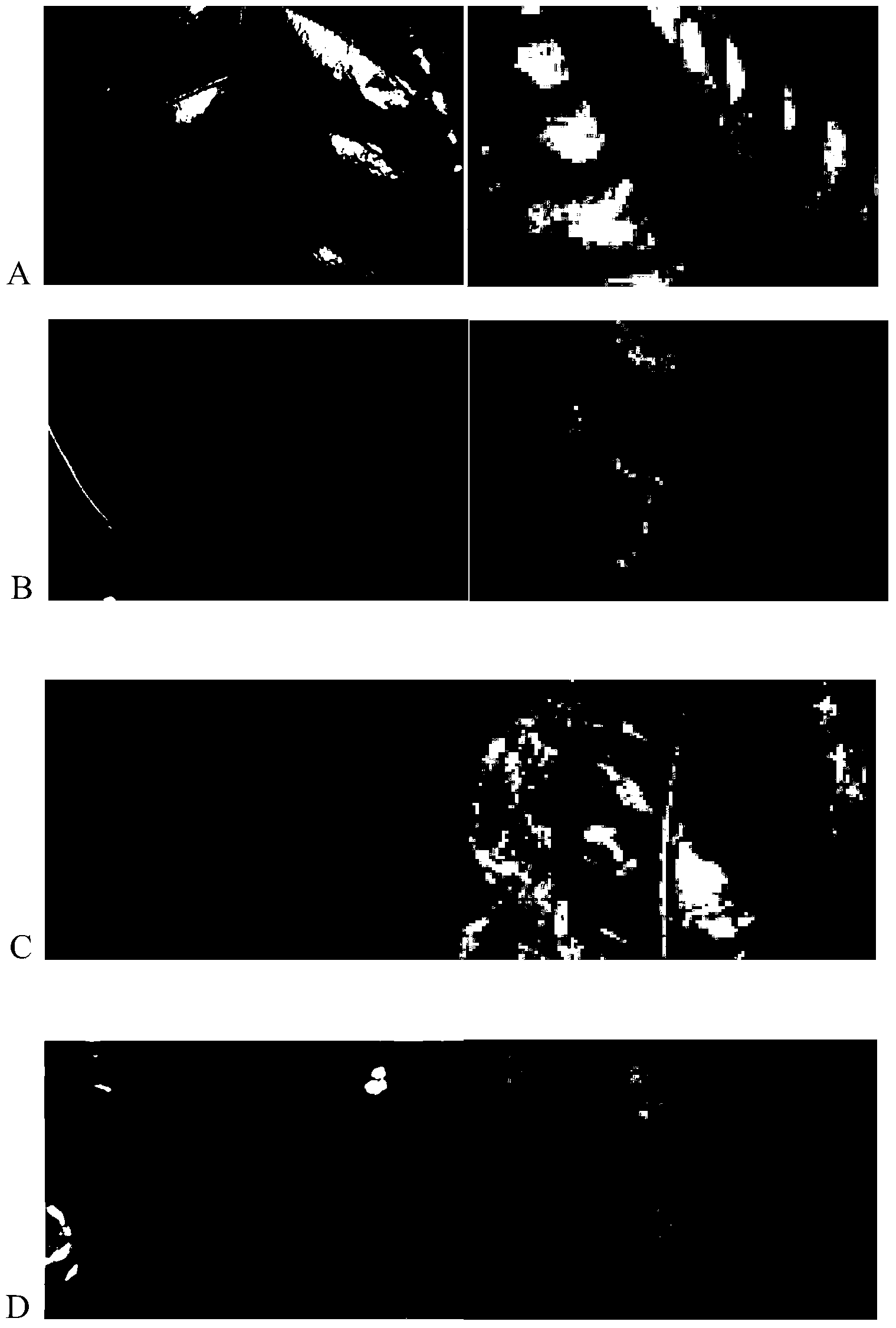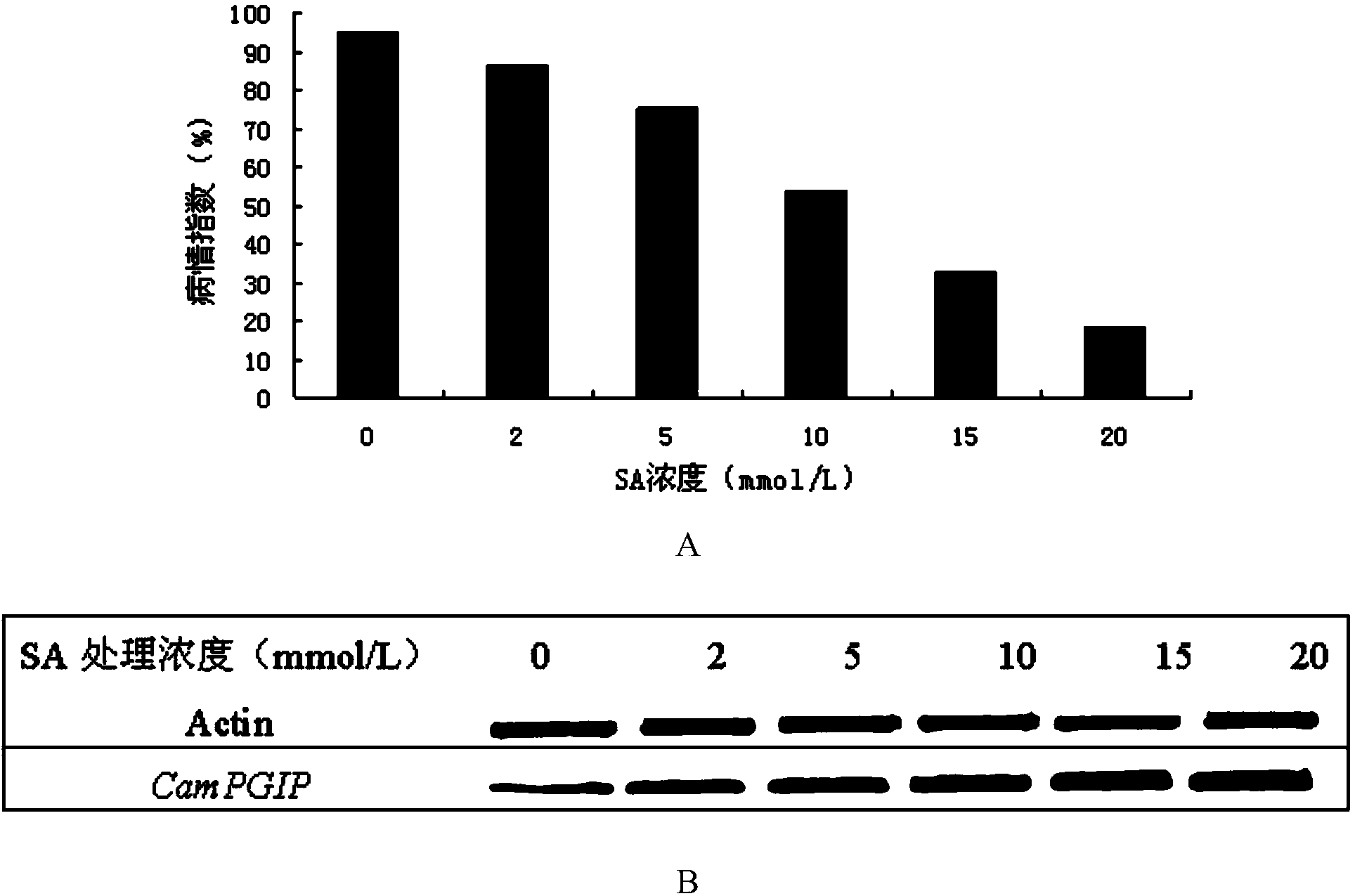Tea tree polygalacturonase inhibitor protein gene CamPGIP and application thereof
A polygalactose and inhibitory protein technology, applied in the application, genetic engineering, plant genetic improvement and other directions, can solve the problems of reducing the quality of tea products, affecting photosynthesis, and declining.
- Summary
- Abstract
- Description
- Claims
- Application Information
AI Technical Summary
Problems solved by technology
Method used
Image
Examples
Embodiment 1
[0033] Example 1: Isolation and cloning of tea tree polygalacturonase inhibitory protein gene CamPGIP
[0034] 1) Isolation of tea tree polygalacturonase inhibitory protein gene CamPGIP by suppression subtractive hybridization (SSH)
[0035] The pathogen-infected leaves of the Fuding Dabai tea tree variety in the tea germplasm resource nursery and the healthy leaves of the same variety with the same maturity were collected, and after being fully ground with liquid nitrogen, the total RNA of the leaves of the two groups of tea trees was extracted by the TRIzol method (Invitrogen Life Technologies) , respectively take the above two groups of total RNA with OligotexTM-dT30 mRNA Purification Kit (Bao Biological [Dalian] Co., Ltd.) to purify mRNA, using PCR-Slelect TM cDNA Subtraction Kit (Clontech Laboratories, Lnc., Mountain View, USA) was used for suppression subtractive hybridization. Take 2 μg of purified mRNA from the above two groups, and use SMARTScribe reverse transcri...
Embodiment 2
[0042] Example 2: Correlation Analysis of Relative Expression Intensity of Polygalacturonase Inhibitor Protein Gene CamPGIP Gene in Tea Tree Leaf and Disease
[0043] 1) CamPGIP gene expression in tea tree diseased leaves and healthy control leaves:
[0044] According to the tea plant polygalacturonase inhibitory protein gene CamPGIP sequence obtained above, use Primer Premier5 software (Premier Inc.) to design expression primers (sequences shown in SEQ ID No: 15 and SEQ ID No: 16), design The product size is 229bp. Simultaneously design reference gene tea tree actin (Actin) gene (http: / / www.ncbi.nlm.nih.gov / nuccore / FJ355923) expression primers (sequences such as SEQ ID No: 17 and SEQ ID No: 18), The designed product size is 419bp.
[0045] "Anthracnose" diseased leaves of "Longjing 43" and "Shuigu" varieties in the tea germplasm resource nursery and healthy control leaves of the same maturity, and "cloud leaf blight" of "Jiukeng" and "Zhenong 25" varieties "Disease...
Embodiment 3
[0053] Example 3: Acquisition and identification of tea tree polygalacturonase inhibitory protein gene CamPGIP tobacco
[0054] 1) RT-PCR amplifies the CamPGIP gene and the amplified fragment is connected to the T-vector
[0055] Primers were designed according to the sequence of the open reading frame (from the 31st to 1023rd base at the 5' end) of the gene shown in SEQ ID No: 1, and Nde I and Sac1 restriction sites were introduced into the primers. The upstream and downstream primers were as follows: Shown in SEQ ID No:19 and SEQ ID No:20, wherein AA is a protective base, the underlined part in SEQ ID No:19 is the Nde I restriction site introduced, and the underlined part in SEQ ID No:20 is The introduced Sac1 restriction site. Total RNA was extracted from shoots of Fuding Dabai tea tree variety with TRIzol reagent, and the first strand of cDNA was synthesized using TaKaRa PrimeScript II1 st Strand cDNA Synthesis Kit (Bao Biological [Dalian] Co., Ltd.). The PCR re...
PUM
 Login to View More
Login to View More Abstract
Description
Claims
Application Information
 Login to View More
Login to View More - R&D Engineer
- R&D Manager
- IP Professional
- Industry Leading Data Capabilities
- Powerful AI technology
- Patent DNA Extraction
Browse by: Latest US Patents, China's latest patents, Technical Efficacy Thesaurus, Application Domain, Technology Topic, Popular Technical Reports.
© 2024 PatSnap. All rights reserved.Legal|Privacy policy|Modern Slavery Act Transparency Statement|Sitemap|About US| Contact US: help@patsnap.com










